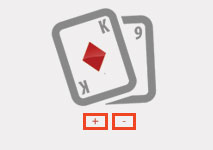Winning Blackjack Strategy
Blackjack is one of the most recognizable table games in the world and it is easily a top pick for millions of players at both web-based casinos and brick-and-mortar gambling venues. Also known as Twenty-One, blackjack is a game in which the player competes against the dealer, aiming to reach a total that is greater in value than the hand of the croupier without going over 21.
Unlike casino classics like roulette and craps, blackjack is not a game that is entirely based on luck. Through advantage play and by making informed decisions, players can exploit the game and eventually end their betting session in profit. The following article provides players with insights into successful blackjack gameplay, including optimal moves such as splitting pairs, hitting, standing, and doubling down. Advantage play will also be briefly discussed.
-
 Sign Up Bonus
Sign Up Bonus
Up to $500
400% Bonus!9.7 -
 Sign Up Bonus
Sign Up Bonus
Up to $3500
350% Bonus!9.4 -
 Sign Up Bonus
Sign Up Bonus
Up to $2000
200% Bonus!9.3
Splitting Pairs
When the player’s starting hand consists of two cards that are numerically identical, they are provided with the option to split them, which forms two separate hands to play and means the player will also make an additional bet. Splitting a pair can improve one’s chances of winning, but it can sometimes weaken the hand as well. Just because you are holding two cards of identical value does not mean splitting them is always the optimal move in blackjack. When considering strategic play, splitting is a move we should make only when our hand indicates it is the optimal action. In addition to assessing the value of your cards, you should also pay attention to the dealer’s face-up card when considering a split. Below, we have listed the cases when splitting a pair is the best option in blackjack.
- As a rule of thumb, Aces are the best pair to split. Do keep in mind that in such cases players are dealt only one additional card on each of the Aces and are not allowed more hits afterward. If a 10 or a ten-value card falls on one or both Aces, the hands will be counted as 21, not as a natural blackjack, which is to say the payout will be even money.
- Splitting a pair of 8s is also always a good idea, regardless of what the dealer is showing. This can be explained by the fact that a pair of 8s adds up to 16, which is considered the worst possible hand one can get in blackjack. When split, the 8s provide players with better probabilities, especially in instances when face cards are drawn on both split hands.
- Another general rule recommends players split pairs of 2s or 3s if the dealer shows 4, 5, 6, or 7, as this decreases their chances of going bust.
- If the dealer shows an up card of 6 or below, splitting pairs of 6s and 7s is a viable option for the player.
- Splitting a pair of 9s is also recommended if the dealer shows 2 to 6, 8, or 9. While 18 is a rather high total, it is still beatable by the dealer. This is why splitting two 9s is the right move whenever the dealer is showing any of the aforementioned cards.
While the aforementioned scenarios are the best cases for splitting pairs, these are the hands you should never split if you wish to improve your chances of winning in blackjack:
- You should never split 10s, since holding a total of 20 on your initial two cards already gives you a huge advantage against the dealer. By splitting two 10s, you risk holding two weak hands, giving the dealer a better chance of beating both of the hands you have formed after the split.
- It is also not recommended to split a pair of 4s, since you cannot go bust in the next deal, with the maximum total you can get by drawing a third card being 19. This is a rather decent total, giving you great chances of beating the dealer. Meanwhile, if you split the 4s, there are only three cards that can make your newly formed hands better and those are a 5, 6, or 7.
- Splitting a pair of 5s would also be a mistake as you have a total of 10, which is one of the best values you can get on your first two cards in blackjack. By splitting the 5s, you risk getting two weak hands or increasing your chances of going bust in the next few card dealings. When holding a pair of 5s, players may opt for doubling down instead of splitting.
Before you start playing any blackjack variant, whether it be at a land-based casino or online, there are a few splitting rules you should check.
- Some games may allow splitting ten-value pairs only if they are of the same rank, meaning you can split 10-10 but not a hand consisting of a Queen and a Jack.
- After a pair has been split, there might be limitations on doubling down or further splitting on the two newly formed hands.
- After a split, a 10-Ace hand may be counted as 21 rather than a blackjack.
- Players who split Aces may not be allowed to hit the newly formed hands more than once.
Hit or Stand?
Many inexperienced blackjack players often face the thorny dilemma of whether to hit (draw more cards from the deck or shoe) or stand (play the cards they already have). Yet, making informed decisions as to when to hit or stand is a pivotal aspect of blackjack. Here are a few basic tips to follow if you are new to the game of 21.
- Players are recommended to hit when their hand’s value totals 8, no matter what card the dealer is showing. With a high number of cards carrying the value of 9 or 10 in the deck, hitting a total of 8 gives you a good chance of getting 18, which is a solid hand in blackjack.
- If you are holding 12 through 16 and the dealer shows 7, 8, 9, 10, or an Ace, you are also advised to hit.
- Hitting on a total of 11 is a good idea whenever the dealer shows an Ace. The dealer showing an Ace is among the least favorable scenarios for players because there are four times as many ten-value cards in the shoe. This means the chances of the dealer drawing more cards with an Ace without exceeding 21 are far greater. Because of this, players are recommended to adopt a more aggressive approach when their hand adds up to 11.
- Whenever the dealer shows 7, 8, or 9, players are recommended to hit rather than double down, provided that their hand’s value totals 9.
- With the dealer holding an up card of 10, players should generally hit if their own hand also totals 10.
- Provided that the dealer reveals 8, 9, or 10, players are advised to hit on soft 18, which is a hand containing an Ace that can be counted as 11 without causing you to go bust.
- Standing is recommended whenever the player obtains a hand that totals 17 or higher, regardless of what the dealer is holding. The only exception to this rule is a soft 17, when you hold an Ace counted as 11 without the risk of busting.
- Standing is also a viable option for players holding a hand that totals 13 or higher, provided that the dealer shows a 6 or lower. As a general rule, 4s, 5s, and 6s are bad news for the dealer because their chances of busting with such up cards are greater than with 3s or 2s, especially on a hot shoe.
- Players are also advised to stand on pairs of 10s or other face cards with a value of 10. A total of 20 is already a good starting hand, so there is no need to ruin it by splitting your pair.
Doubling Down
Doubling down is one of the most popular options among blackjack players. A double down basically means the player doubles the size of their initial wager after they have already been dealt their starting hand. After a double down, the player receives only one additional card and is not entitled to draw more cards from the shoe or deck.
It is important to mention that this option is permitted only on certain hand values and the rules for doubling down vary, depending on the casino you play at. In some gambling establishments, players are allowed to double down only on hands that total 11. We have outlined two basic rules to follow when it comes to doubling down in blackjack.
- Doubling down is a viable option for players with hands that total 9 whenever the dealer shows a bust card like 4, 5, or 6. Another option is to double if you hold an Ace with a 2, 3, 4, 5, or 6 and the dealer has 5 or 6. The reasoning here is that the number of cards in the deck that can help you is greater. Besides, the chances of the dealer busting with their 5 or 6 are substantial.
- Doubling down works to the players’ advantage whenever they hold a hand that totals 10 or 11. There is a simple explanation behind this – there are sixteen different ten-value cards in a standard 52-card deck, which means your chances of hitting 20 or 21 through doubling down are better.
In addition to the best cases for doubling down, we would like to highlight the scenarios when this action is not recommended:
- While it may seem obvious, doubling down against a dealer’s Ace is not the optimal move, as there is a significant chance of the dealer getting a blackjack or a total closer to 21.
- If players are holding a hand with a total over 11, doubling down is not recommended, as they risk busting if they draw another card.
- Generally speaking, if you feel uncertain about your hand, you should avoid doubling down, as this option increases the risk level and you may end up losing a substantial amount if you are always opting for the double down.
Advantage Play and Card Counting
 Card counting is considered a foolproof way for players to swing the advantage in their favor and gain the upper hand (both literally and figuratively) in blackjack. It ranks among the most important aspects of advantage play and is incorporated by many skilled and experienced blackjack players. What is more, card counting renders blackjack one of the casino games that are actually beatable as it greatly reduces the house edge.
Card counting is considered a foolproof way for players to swing the advantage in their favor and gain the upper hand (both literally and figuratively) in blackjack. It ranks among the most important aspects of advantage play and is incorporated by many skilled and experienced blackjack players. What is more, card counting renders blackjack one of the casino games that are actually beatable as it greatly reduces the house edge.
In most general terms, card counting involves keeping track of the ratio of high-value to low-value cards remaining in the shoe. The latter may contain anywhere between two and eight standard decks. The Hi-Lo is among the most popular card-counting systems. Cards between 2 and 6, inclusive, are assigned a value of +1, while 10s, Aces, and picture cards are given the value of -1. The 7s, 8s, and 9s are neutral and, as such, are assigned a value of 0.
On the basis of this, the player keeps a running count, which is established on the values of the cards that are dealt. The advantage player would then derive a true count in multiple-deck games by dividing their current running count by the number of decks left in the shoe.
Logically, it follows that advantage players would increase the size of their bets whenever the shoe is “hot”, i.e. the count is higher, because there is a greater number of high-value cards to be dealt. When the count drops and the shoe “cools off”, the player’s edge decreases and they adjust their following wagers accordingly, betting smaller amounts.
Keeping track of the cards that are removed from the shoe can help players make more adequate decisions and adjust their bets accordingly. However, mastering this form of advantage play is not for everyone; it requires a lot of time, persistence, patience, and, above all, practice. In addition, counting cards in online blackjack games (where the outcome is determined by RNGs) is impossible, since the shoe is reshuffled after each hand.
Rule Variations that May Alter Blackjack Strategy
Even if you master blackjack strategy and know the optimal move for every hand total, there are multiple variations of the game that may require slight changes in the strategy players use. With alterations to some blackjack rules, players might need to reconsider when doubling down, splitting, standing, or hitting is the optimal move. Below, we will take a look at key blackjack rules that you always need to consider before you approach the game of blackjack with strategic play.
Soft 17 Rule
Depending on the table rules, you may see that the game requires the dealer to hit on soft 17 rather than stand on that type of total. While inexperienced players might neglect the importance of this rule, we can assure you that it has a serious effect on the strategy used in the game. If the dealer is required to hit on soft 17s, it is expected that they might bust more often, giving players a bigger advantage. However, when the dealer does not bust by hitting a soft 17, they get closer to the total of 21, increasing the house’s chance of beating players.
When the dealer is required to hit on soft 17, the following adjustments to the basic blackjack strategy need to be made:
- Instead of hitting a total of 11 against a dealer’s Ace, players are recommended to double down.
- Rather than standing, it is suggested to double down on a soft 18 against a dealer’s 2.
- Rather than standing on a soft 19 against a dealer’s 6, players are advised to double down.
Surrender Rule
Some forms of blackjack allow players to take either a late or early surrender, which means they forfeit their hand and get half of their original bet back. Both types of surrender options affect your strategic play, requiring specific adjustments to the gameplay. With late surrender, players are allowed to forfeit their hand only after the dealer peeks for a blackjack after showing an Ace or a ten. If the dealer shows a blackjack, the surrender option is no longer available and the player loses their entire bet unless they are also holding a blackjack. If late surrender is available in a six-deck blackjack game where the dealer stands on all 17s, you should alter your strategy in the following manner:
- Rather than hitting on a 15 against a dealer’s 10, opt for late surrender.
- Instead of hitting on a 16 against a dealer’s 9, 10, or Ace, opt for late surrender. This does not apply to a pair of 8s, as the optimal move in this case is to split.
Early surrender is very common in European blackjack where the dealer does not draw a hole card until players have acted on their hands. With this type of surrender, players can forfeit their hands against a dealer’s Ace or 10-value card before the dealer checks for a blackjack. If you opt for a multi-deck blackjack variation that offers early surrender, follow these strategic actions:
- Surrender hard 5 to 7 (including a pair of 3s) and 12 to 17 (including 6-6, 7-7, and 8-8) against a dealer’s Ace.
- Surrender hard 14 to 16 (including 7-7 and 8-8) against a dealer’s 10.
- Surrender hard 16 (10-6 and 9-7), excluding a pair of 8s, against a dealer’s 9.
Double Down After Split
While doubling down after a split is allowed in most blackjack variations you can find at land-based casinos as well as online, there are some variants that do not allow this action after players split a pair. If you have come across a multi-deck variation of the game of 21 where the dealer stands on all 17s and doubling down after a split is not allowed, you are advised to adjust your strategy in the following way:
- Hit on a pair of 2s or 3s against a dealer’s 2 or 3.
- Hit on a pair of 4s when the dealer is showing a 5 or 6.
- Hit on a pair of 6s if the dealer is showing a 2.
No Hole Card Blackjack
In many variations of European blackjack, the dealer does not draw a hole card until after all players have acted on their hands. While this rule may not have a significant effect in the long run, it does impact the house edge, as players might end up losing to a dealer’s blackjack after they have already doubled up or hit their hands. This is why the no-hole-card rule requires some changes to the basic blackjack strategy, asking players to:
- Hit a hard 11 when the dealer’s first card is a 10.
- Hit a pair of Aces when the dealer’s first card is an Ace.
- Hit a pair of 8s (instead of splitting) when the dealer’s first card is an Ace or 10.
*It should be noted that the aforementioned actions are optimal when the game does not offer surrender.
Number of Decks Used in Blackjack
Another very important blackjack rule that may affect your strategic play is the number of decks used in the game. The fewer decks used in blackjack, the greater the impact removing a card from the shoe will have. This rule is of great importance for strategic play when doubling down is concerned. Players who double down gain a bigger advantage if they play a single-deck blackjack game instead of an eight-deck variation.
In most cases, players are advised to double down whenever they are holding a hard 9, 10, or 11, totals achieved by drawing two lower-value cards. By removing two smaller cards from a single deck, the remaining cards that have not been drawn will be richer in high-value cards. However, removing low-value cards from an eight-deck game has a very insignificant effect on the game, making doubling down a more prudent strategy in games that use fewer decks. You will notice that the more decks are used in blackjack, the fewer totals will suggest players double down. Meanwhile, in single-deck blackjack, strategy advises players to double down on a significantly higher number of hands.


